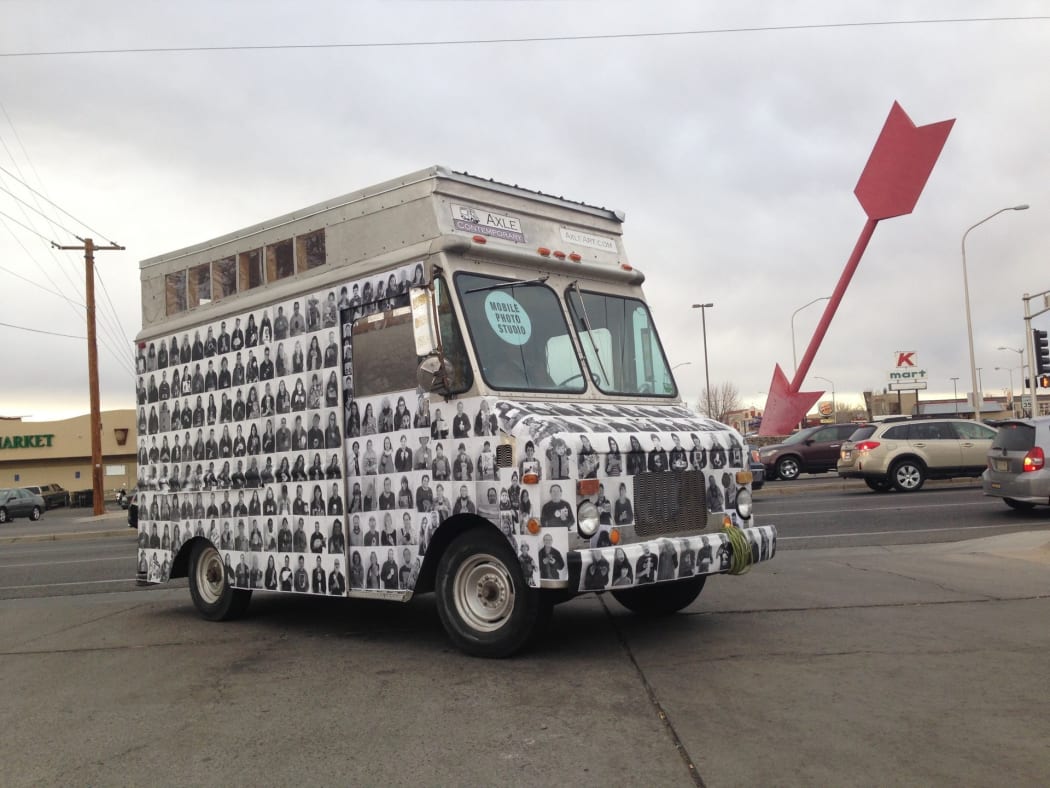
As the rest of the world shut down due to the Covid-19 pandemic, Jerry Wellman and Matthew Chase-Daniel of Axle Contemporary were revving up for a year of dynamic art projects. Operating out of a custom retrofitted 1970 aluminum stepvan, the nonprofit art space was agile enough to tackle every challenge that this socially distanced year threw at them. In this interview, cofounders Jerry and Matthew discuss Axle's wild ride in 2020—from a major digital pivot to the truck's triumphant (and safe) return to the streets of Santa Fe.
This spotlight is part of our Partners in Art series, designed to support arts organizations in the midst of the Covid-19 crisis. As part of the program, Axle is offering a selection of artworks from their recent projects and exhibitions. All proceeds go to Axle, so please consider acquiring a piece if you’re able. Although part of Axle's mission is to support artists through sales, you can also help them out by donating directly to the project.

Miranda Gray, Sister.
You founded Axle in 2010, so this is your 10-year anniversary! Give me an abridged version of Axle’s origin story.
Jerry Wellman: Matthew and I, our kids went to the same school. We just kind of hit it off, saw each other at after-school meetings. Matthew was doing this project…
Matthew Chase-Daniel: I was taking photographs of artists working in their studios, composite, grid, photo assemblage. I asked Jerry if I could shoot photos of him working in his studio.
J: The photos led to just generally shooting the shit about ideas and stuff. I had this miniature RV that I was thinking of gutting and turning into a miniature art gallery.
M: Then I saw this truck on the side of Old Las Vegas Highway. It was a 1971 International Harvester, a yellow and red flatbed truck. It was this beautiful machine, so I was thinking of why I should buy it. My son was 14 at the time. He could’ve used a little space, so I was thinking I could buy it and drive it to my house, and he could use it as a bedroom out in the back meadow.
I started talking to Jerry about buying the truck and starting a little art gallery. We went and looked at the truck, but neither of us are mechanics and it needed a lot of fixing up. Then we found a little bread truck up in Colorado Springs.
Guy Cross [the former editor and publisher of The Magazine] offered us a free ad that was coming out that September, so we had to get it up and running by then. We got coverage in Santa Fe Reporter and reached out to everyone we knew. Tons of people showed up for the first show, outside Billy Siegel’s gallery on Guadalupe Street. There was huge enthusiasm, we had obviously hit a nerve. Then we incorporated as a not-for-profit, so that we could get more funding.
J: We got a write-up in the New York Times, which basically shocked the shit out of us. We said, “Oh my god, we’ve got to keep this going.” Matthew and I are restless people in general, and we were looking to have fun. Those were the main things.
Okay, now let’s fast forward to this past spring. As the directors of an art space, what was your initial reaction as the pandemic set in?
M: We were worried. We had a bunch of things planned—nothing in February, but starting in March—so the shutdown all happened before we would’ve done anything. We ended up postponing our full spring and summer season. Gradually, we postponed everything.
Then we started coming up with things we could do. We had made a coloring book, featuring five stories by New Mexico writers and illustrated by five New Mexico artists a few years ago. We started offering those five stories and coloring pages as free downloads. That was the first thing we did to adapt. We said, “What can we possibly do that is safe?”

The Furies, Vengeance.
Axle is inherently a very nimble project. Do you think you were particularly suited to a digital migration?
J: Axle’s always been about flexibility, and being able to show up where no one else can show up. In this case it was just online.
After the coloring book, we started Random Inspirations, which was also an online project. Matthew and I took turns for six or seven weeks. We would grab one of our favorite books and point to a word on that page, and ask anybody to submit a drawing or a painting, or whatever was inspired by that word. The winner of each week received a small honorarium and we published that work.
M: We had a really great group of enthusiastic people.
J: That worked on the level of Axle’s mission, which was to reveal to each other what our culture of artists and makers in New Mexico is. We had curators, we had artists. At that time, a lot of galleries and museums were basically doing tours of their shows, which to me was not really a great use of the Internet. We wanted to use the Internet as an art piece as well.
That brings us to the Broadsidesproject, which moved back to Axle’s physical space—albeit on its exterior. How did that come together?
J: Broadsides used the entire exterior of the van for different art expressions.
M: We put out a call to artists for proposals. Jerry and I chose Basia Irland and Andres Machin. I have a big large-format printer so we were able to take their designs, print them at 16 feet long and 10 feet tall, and wheat paste them up on all sides of Axle. They were up for about a month each, so people could see them out in the world, but not in a way that was dangerous for them.
Did being back out on the streets for Broadsides show you how Santa Fe has changed since the pandemic hit?
M: In March, April and May the streets were really empty. Now there’s a little bit more life on the street. I just saw a music performance across the street from SITE Santa Fe, a little New Orleans brass band playing. There were only a few people listening, but I think in little ways, there are things happening again.
The little things we can do to animate public spaces are valuable. We don’t know how everyone reacts, but we know that people see Axle and it helps a little bit. Just spreading a little bit of love and light out into the world is a good thing.
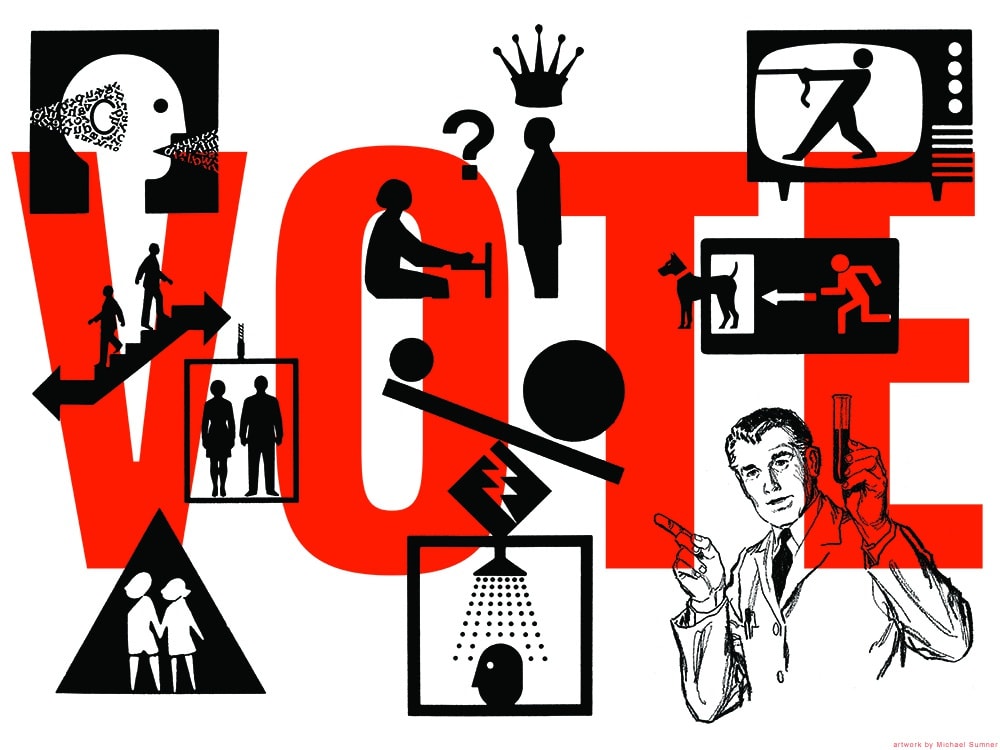
Michael Sumner, Yard Sign (2020).
Any other recent projects?
M: We’ve been doing this Be Counted sign program to get out the vote. There’s a show up right now called Feminist Art in the Trump Era, juried by Lucy Lippard who’s on our board of directors, which we ended up showing on the exterior of Axle in the manner of Broadsides.
We also worked in conjunction with CURRENTS to do the International Endoscopic Film Festival. We had already put out the word on that and selected works. That was easy to transfer online. People can stream it on our website.
That is a very busy schedule, even for normal times! How did you measure success for each project in this very strange moment?
M: We don’t do a lot of number evaluation with Axle, in general. We’ve never put up a webcam outside of Axle to count who shows up and how long. We’re just parking Axle in places where, in our ten years of experience, a lot of people will see it. We get some emails and social media responses, but mostly we trust that it’s working. With the new digital stuff, we were checking Google Analytics for a while.
J: A lot of the way we understand our impact comes from anecdotal evidence. We hear from many, many people, over and over again how much they love our program. The reason we’ve been so busy in the last few months is because people are reaching out to us and inviting us to do programs with them. It’s been pretty overwhelming for us, how many different organizations have reached out to us lately.
M: Yeah, there’s a lot more coming up. We’ve been doing this Be Counted sign program to get out the vote, and Youthworks is printing 300 t-shirts with images from that project. We’re working with the Santa Fe Poet Laureate Elizabeth Jacobson, who has a fellowship with the Academy of American Poets, to do a big poetry and art project next year. We may be working with New Mexico Arts and the Museum of Indian Arts and Culture, distributing artmaking kits to rural areas sometime in the next few months. Oh, and we’re working with ARTsmart to produce coloring books.
So many creative folks were hunkering down at the beginning of the pandemic, but it seems like you two were speeding up! Have you had any downtime?
J: It’s been a little of both, to be honest. There was a period when this first hit in March, when I got a lot of work done that had been sitting around for almost a decade. I was just jamming. That has practically come to a standstill. I would like to get back to that. We’re going to take a brief period off this winter. We usually do take a brief period around January.
M: I don’t find the pandemic crisis energy to be very conducive to making my own personal creative work. Because I’m somewhat cooped up and not feeling like doing that, I’ve gotten busy doing this. That’s partly because I feel like it’s important to the world or the Santa Fe community, and partly out of my own nervous energy or anxiety. My wife as well has gotten involved in a Covid relief project that is taking up huge amounts of her energy. So we’re here, cooped up and just spending endless time working on projects.
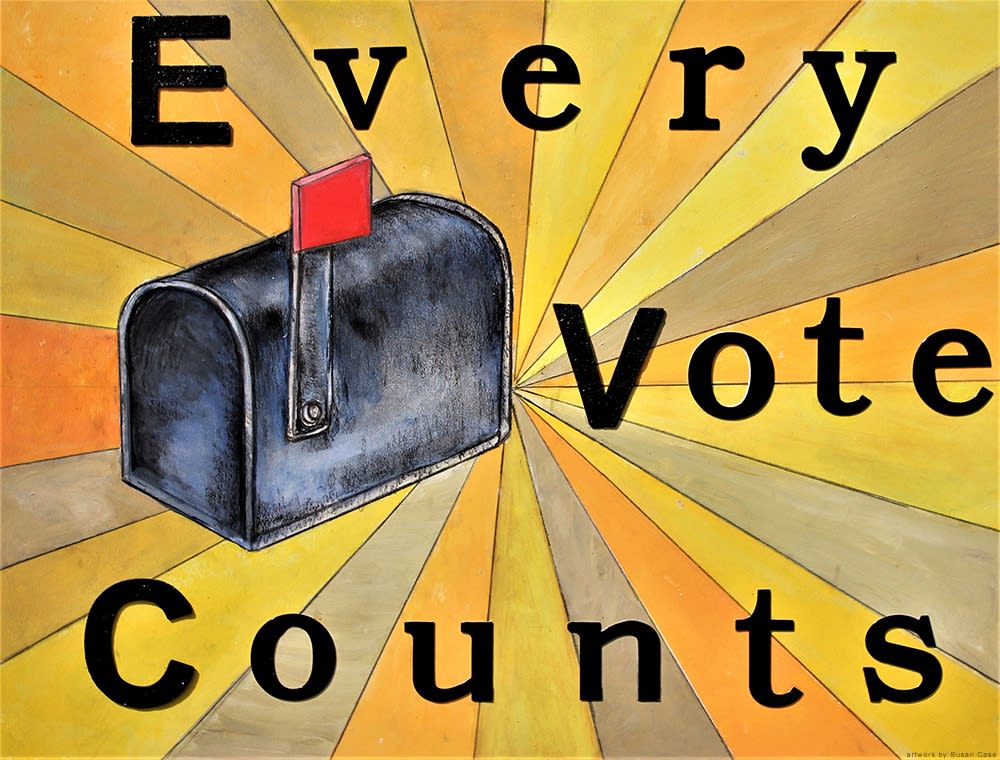
Susan Case, Yard Sign (2020).
DO YOU CONSIDER YOUR MISSION CROSS-DISCIPLINARY?
J: Right from the get-go, we have had and wanted to encourage a wide definition of art and art expression.
M: I would say we see ourselves as a visual arts organization, but there’s so many ways that can go. It could be visual art and writing, or visual art and performance.
What do you hope people who engage in Axle programming come away with?
J: These are weird words, but I want people to be inspired and empowered. They’re so overused that they become cliché, but those are the two words that I’m thinking of. I hope people see these works of art and are inspired to make more work, or to realize that there are other people out there that are expressing the things that they’re thinking. That we’re all thinking the same things right now.
In such a divided time (physically and politically), maybe art can help remind us that we have more in common than we think?
M: I think it can go either way. It can bring people together, but it can also amplify differences. Our feminism show right now is very strong. Although there were no parameters to what “feminism” meant, we didn’t get any pro-Trump feminist artworks for that show. I’m sure for some people, seeing that work, it pulls them together. It’s like, yes, together we can make a difference, we can change the world and change the direction. When you make strong statements, it draws people together and it also splits people apart, but in all cases it inspires people to think and reflect. That’s the most important part.
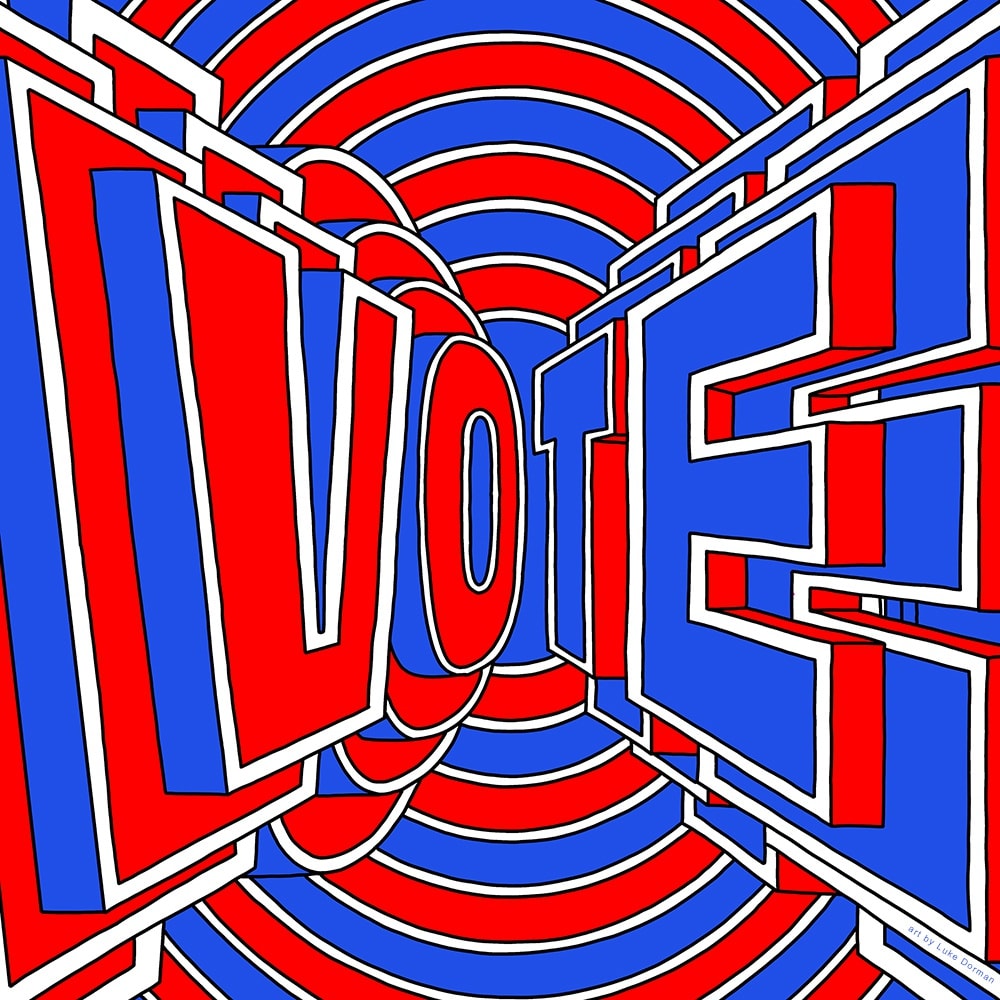
Luke Dorman, Yard Sign (2020).
Is there an activist element to Axle’s mission?
M: We run Axle as a nonprofit, 501c3, so we’re not allowed to be a partisan organization. We can be activists but we’re not allowed to be partisan. Our voting initiative is nonpartisan. There’s no pro-Trump or pro-Biden or anti-Trump or anti-Biden work.
I feel like there’s a lot going on in the world in the past few months, which calls for a lot of thought and activism. We’re engaging with that to the best of our ability, and value that personally. But we also really value showing art that shows joy and beauty, and isn’t always showing suffering and revolution. We really try to embrace a broad array of what contemporary art can be, as expressed by artists in New Mexico during our time.
J: The word "activist," how might that be defined? Activism is giving voice, and the power that comes from having participated in that voice. I think any form of creative expression is creating an action. So it’s a much more open definition of activism. I feel that there’s a narrower definition of activism, which might be called social activism. I think we’re interested in a wider definition of what activism can be.
I honor and respect all the aspects that are coming out of this recent focus on social activism, but I also feel that activism can have this broader definition as a conduit to empowerment.
M: In Santa Fe and in the contemporary art world all over, there’s a lot of straight old white men. I think trying to work to give a voice to other people and perspectives is important, and that’s part of what we aim to do.
J: There are different ways of exploring cultural background. Culture is what’s really important, more than anything. We can help to shape culture as artists. There are many ways to shape culture.
Explore artworks from Axle, or donate directly to the nonprofit project!
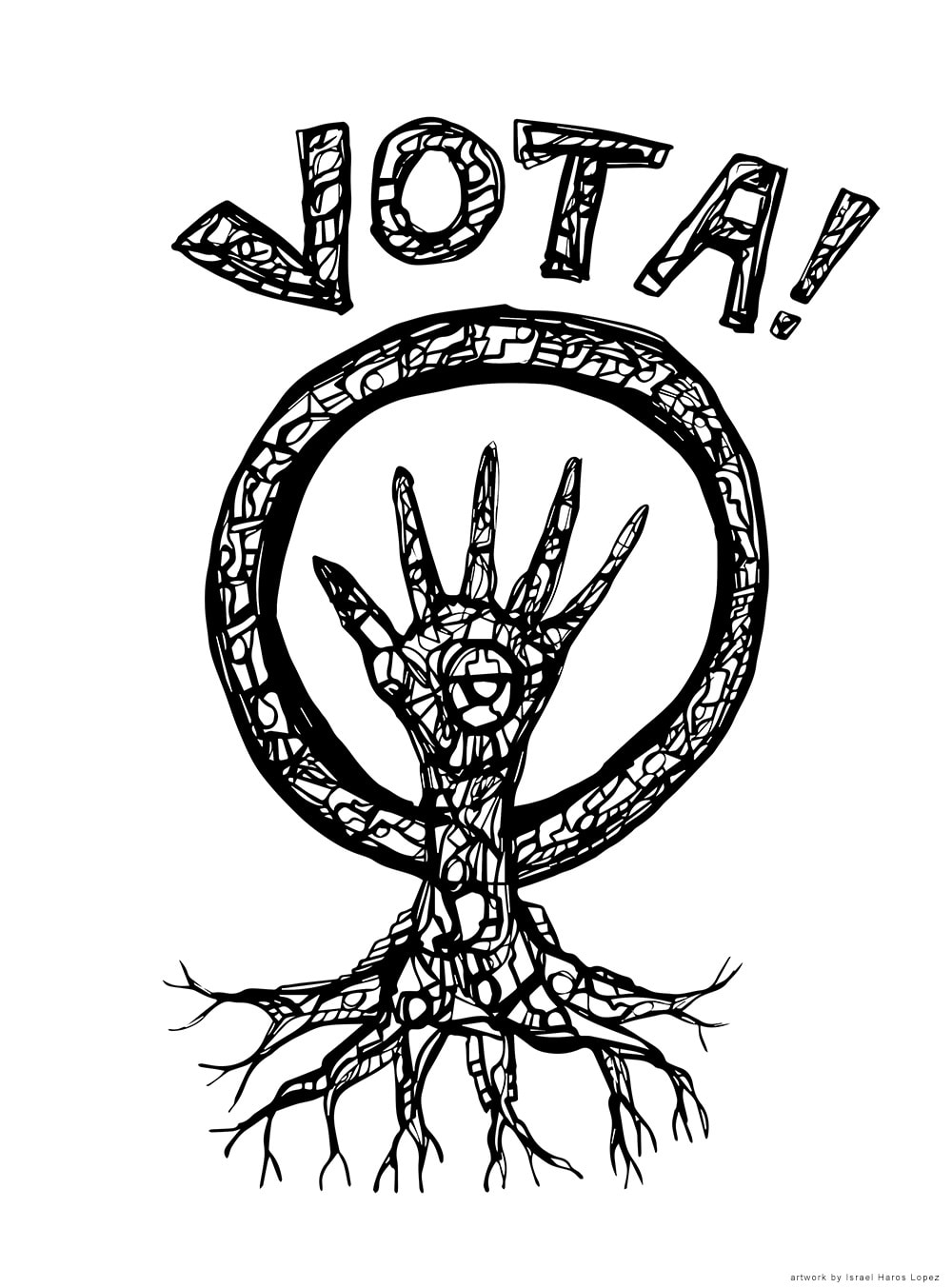
Israel Haros Lopez, Yard Sign (2020).